摘 要: 盐城自然保护区是全球水鸟重要的越冬地之一, 随着近几十年来围填海活动强度的不断增加, 其景观格局发生了重大变化, 这种改变势必会影响越冬水鸟的群落结构和空间分布。因此, 以盐城自然保护区北缓冲区和核心区作为研究区, 根据1975—2013年研究区土地利用类型变化图将其划分为围垦区和未围垦区, 分析了2009—2013年围垦区和未围垦区之间越冬水鸟种类、数量、多样性和空间分布的差异。结果表明:1) 围填海对水鸟的种类组成具有显着的影响, 围垦区雁鸭类水鸟的种类和数量显着高于未围垦区。土地利用类型的改变对水鸟的种类数具有显着影响, 围填海对芦苇和盐田的水鸟种类数量影响显着;2) 围填海造成土地利用类型的改变对水鸟的Shannon-Wiener指数具有显着的影响, 其中围垦区鱼塘的Shannon-Wiener指数显着高于未围垦区;3) 未围垦区碱蓬生境水鸟多度最大, 围垦区芦苇生境水鸟多度最大, 围填海造成的生境类型的改变对鹳类、鹤类、鸻鹬类、雁鸭类水鸟的栖息地选择具有较大影响。结果强调围垦后生境的可利用性和人为干扰大小决定了水鸟的群落结构和空间分布。
关键词: 围填海; 水鸟群落; 多样性; 空间分布; 盐城保护区;
Abstract: Yancheng Nature Reserve is one of the important wintering sites for waterbirds in the world.With the increasing intensity of the reclamation activities in recent decades, the pattern of landscape has changed greatly.This change will certainly affect the community structure and spatial distribution of wintering waterbirds.We took the north buffer zone and the core area in Yancheng Nature Reserve as the study area.According to the landscape map of Yancheng Nature Reserve in 1975-2013, we divided the study area into nature area and reclaimed area.The species, population, diversity and spatial distribution of wintering waterbirds in nature area and reclaimed area during2009-2013 were analyzed.Our results showed that:1) Reclamation had a significant influence on the species composition of waterbirds, and the species and population of Anatidae in the reclaimed area are significantly higher than those in the nature areas.The change of land use type had a significant influence on the number of waterbirds species, and the influence of reclamation on the population and species of waterbirds in reed and salt works was significant.2) The change of land use types caused by reclamation had a significant influence on the Shannon-Wiener index of waterbirds, and the Shannon-Wiener index of fish ponds in reclaimed area was significantly higher than the nature area.3) The abundance of waterbirds in Suaeda glauca was largest in nature area and in Phragmites australias was largest in reclaimed area.The change of land use types caused by reclamation had a great influence on the habitat selection of storks, cranes, shorebirds and Anatidae.Habitat availability and human disturbance after reclamation determined the community structure and spatial distribution of waterbirds.
Keyword: reclamation; shorebirds community; diversity; distribution; Yancheng Nature Reserve;
1 前言
近年来由于人口的增加和快速城市化, 人们通过围填海造地的方式来缓解用地压力并从中产生一系列经济效益。在世界沿海国家中, 欧洲和亚洲国家滨海地区的围填海活动最为盛行[1]。我国从新中国成立至今, 沿海区域经历了四次围填海高潮, 围海晒盐、农业养殖、建设工业开发区、旅游区以及大型基础设施等占据大面积的自然湿地[2], 进而对滨海湿地生态系统造成巨大威胁[3,4], 这对依赖于自然湿地的水鸟、大型底栖动物的生存极为不利[5,6]。从水鸟数量上来说, 围填海将导致水鸟数量减少。有研究表明新万金自然湿地的大面积开发利用使得水鸟数量在南迁期间下降了97.3%[7]。在黄渤海地区, 自然滩涂面积的减少是大滨鹬 (Calidris tenuirostris) 、红腹滨鹬 (Calidris canutus) 和斑尾塍鹬 (Limosa lapponica) 种群数量下降的主要原因[8,9]。从水鸟栖息地来说, 围填海将改变水鸟适宜栖息地的选择。围垦区大面积的自然滩涂转变为农田、工厂等, 迫使一些水鸟只能利用人工湿地作为补充生境[10]。在崇明东滩, 围垦造成互花米草 (Spartina alterniflora) 入侵导致海三棱藨草 (Scirpus mariqueter) 和养殖塘等水鸟适宜生境面积下降, 水鸟栖息地正由自然湿地向人工湿地转变[11]。围填海导致底质环境遭到破坏, 大部分底栖生物被掩埋, 其生存率均降低50%以上[12], 有研究表明, 在临近围填海区域, 底栖动物中科数目和丰度都显着降低, 而远离围填海区域, 则均显着增加[13], 这也是水鸟更倾向于选择未围垦区作为栖息地的重要原因。
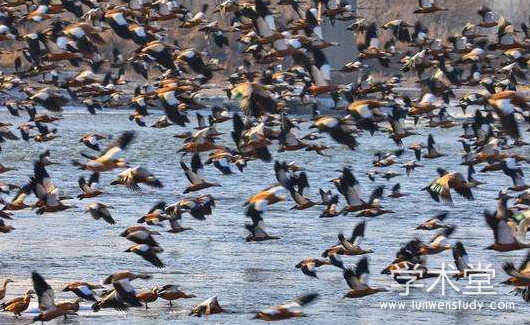
目前, 国内外有关围填海对水鸟影响的研究主要关注不同年份间水鸟的差异[14,15,16], 而较少关注到相同年份内未围垦区与围垦区间水鸟的差异。本研究以盐城珍禽国家级自然保护区核心区和北缓冲区内越冬水鸟为主要对象, 通过研究区域内未围垦区和围垦区越冬水鸟种类、数量、多样性和空间分布差异来阐述围填海对水鸟群落的影响, 试图回答以下问题:1) 围填海对水鸟种类、数量的影响;2) 围填海对水鸟多样性的影响;3) 围填海对水鸟空间分布的影响。
2 材料与方法
2.1 研究区概况
盐城自然保护区是我国最大的海岸带保护区, 跨响水、滨海、射阳、大丰、东台五县。它位于中国海岸线中段、苏北平原东部, 东临黄海, 在北纬32°48′47″—34°29′28″, 东经119°53′45″—121°18′12″, 海岸线长582 km, 南北长约200 km, 总面积247260hm2 (图1) 。北部滨海县与响水县实验区主要为盐田;射阳县北部实验区主要为养殖塘和盐田, 中部的缓冲区为养殖塘和农田, 南部的核心区是较原始的芦苇和滩涂湿地;大丰县北部为核心区, 情况与射阳县核心区类似, 缓冲区以养殖塘为主, 实验区以养殖塘和农田为主;东台境内为实验区, 主要包括养殖塘、农田以及未开发的滩涂湿地;东沙岛为较原始的滩涂湿地。
2.2 试验方法
2.2.1 调查方法
2009—2013年水鸟调查采用样点法, 在每年的12月份至次年1月份 (每个调查周期为5天) 进行调查。调查条件一般为天气晴朗、风力较小 (3级以下) 。每次调查以2到3人为1组, 使用OLYMPUS双筒望远镜 (10×42倍) 和Zeiss 85单筒望远镜 (30×60倍) 对各样点进行观察, 记录样点半径1 km内的鸟类种类、数量等。
鸟类调查时, 统计从样圆外向样圆内飞入的鸟类, 而从样圆内向样圆外飞出的鸟类则不进行统计。当鸟类集群数量较小时, 直接记录各种鸟类的种类、数量等;在鸟类集群数量较大, 同时鸟类又处于迅速活动状态, 无法准确统计鸟类数量时, 通过辅助拍照的方式来估计集群数量[17]。
2.2.2 数据分析
结合保护区1975—2013年生境类型图, 以1975年为原始生境, 将研究区划分为围垦区和未围垦区 (图1) 。在研究区内选取24个半径为1 km的取样区域 (其中未围垦区域内12个, 围垦区域内12个) , 取样区域尽可能包含这5年的样点 (区域内每年的样点只考虑一个) , 统计5年内落在取样区域内的水鸟种类和数量。将数据导入SPSS 21.0中分析 (ANOVA) 围填海对越冬水鸟的种类 (分为鹳类、鹤类、鸻鹬类、鹭类、鸥类、琵鹭类、雁鸭类和其他8类水鸟) 、数量和Shannon-Wiener指数的影响, 如果影响显着则再进行Least Significant Difference (LSD) 分析。在Arcgis 10.2中对取样区域内的水鸟多度进行克里金插值, 分析围填海对水鸟空间分布的影响。
图1 研究区位置及取样区域示意图Fig.1 The location of study area and sampling area
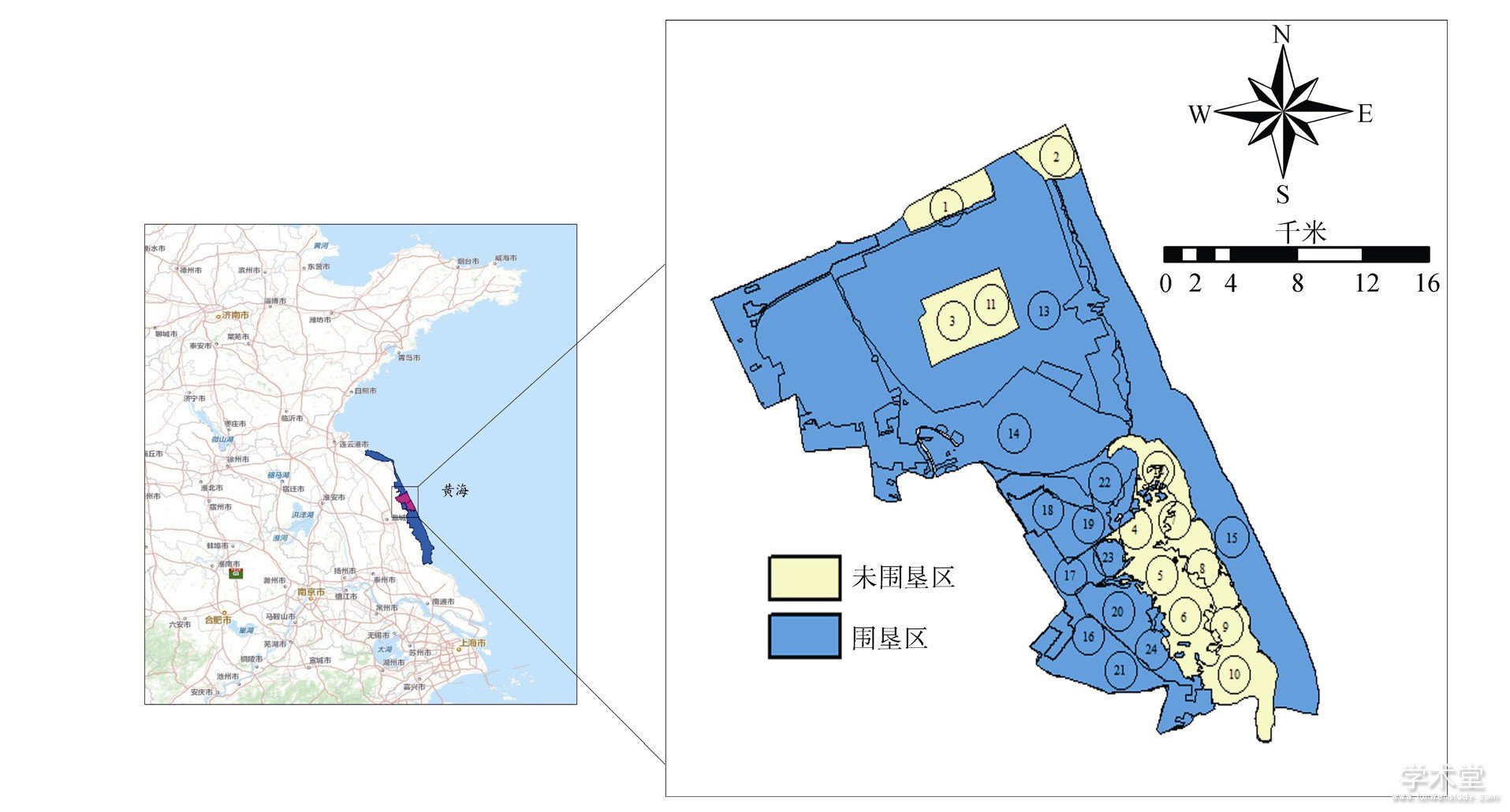
注:底图版权所有:北京捷泰天域信息技术有限公司。
Shannon-Wiener指数 (H’) :
式中, S为物种数, Pi为第i种物个体数与总个体数的比值;H’为实测群落的多样性指数值。
3 结果与分析
3.1 越冬水鸟种类组成及数量
2009—2013年样点区域内有水鸟60种 (表1) , 其中雁鸭类水鸟种类最多, 达到24种;其次是鸻鹬类, 有10种;鹳类最少, 仅为2种。记录到国家一级重点保护鸟类3种, 分别为丹顶鹤 (Grus japonensis) 、东方白鹳 (Ciconia boyciana) 和白鹤 (G.leucogeranus) ;国家二级重点保护鸟类7种, 分别为白琵鹭 (Platalea leucorodia) 、大天鹅 (Cygnus cygnus) 、黑脸琵鹭 (Platalea minor) 、灰鹤 (G.grus) 、沙丘鹤 (G.canadensis) 、鸿雁 (Anser cygnoides) 和灰雁 (A.anser) 。
3.2 围填海对水鸟群落结构的影响
3.2.1 围填海对水鸟种类数量的影响
围填海对水鸟的种类数和数量无显着影响 (P1=0.124, P2=0.221) , 未围垦区水鸟平均为2.3种、526.14只, 围垦区水鸟平均为3.11种、744.92只。但是围填海对水鸟的种类组成具有显着影响 (P=0.02) , LSD分析显示围垦区雁鸭类水鸟种类数量明显高于未围垦区 (P1=0.021, P2=0.04) (图2) 。未围垦区雁鸭类水鸟平均为3.4种、986.3只, 围垦区雁鸭类水鸟平均为6.8种、2294只。围填海造成土地利用类型的改变对水鸟的数量无显着影响 (P=0.584) , 但是对水鸟的种类数具有显着影响 (P=0.014) , LSD分析显示围填海对芦苇和盐田的水鸟种类数影响显着 (P1=0.015, P2=0.015) 。
3.2.2 围填海对水鸟多样性的影响
未围垦区光滩生境的Shannon-Wiener指数最高, 其次为盐田, 鱼塘最低;围垦区内芦苇的ShannonWiener指数最高, 其次为鱼塘, 农田最低 (图3) 。围填海对水鸟多样性无显着影响 (P=0.305) , 未围垦区Shannon-Wiener指数为0.051, 围垦区为0.059。但是围填海造成土地利用类型的改变对水鸟的Shannon-Wiener指数具有显着的影响 (P=0.04) , 其中围垦区鱼塘的Shannon-Wiener指数显着高于未围垦区 (P=0.03) 。
表1 2009—2013年取样区域水鸟种类组成及数量Table 1 The species composition and population of waterbirds in sampling area during 2009-2013
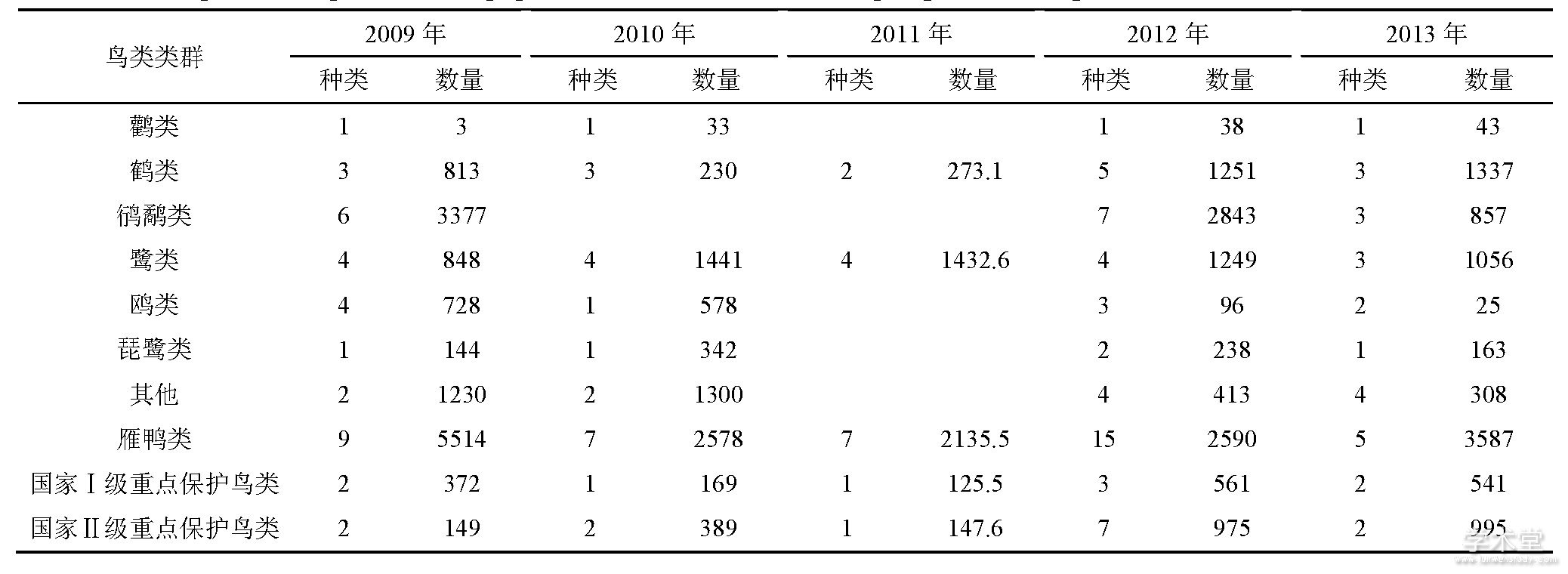
图2 2009—2013年围填海对雁鸭类水鸟种类数量的影响Fig.2 Effects of reclamation on the species and population of Anatidae during 2009-2013
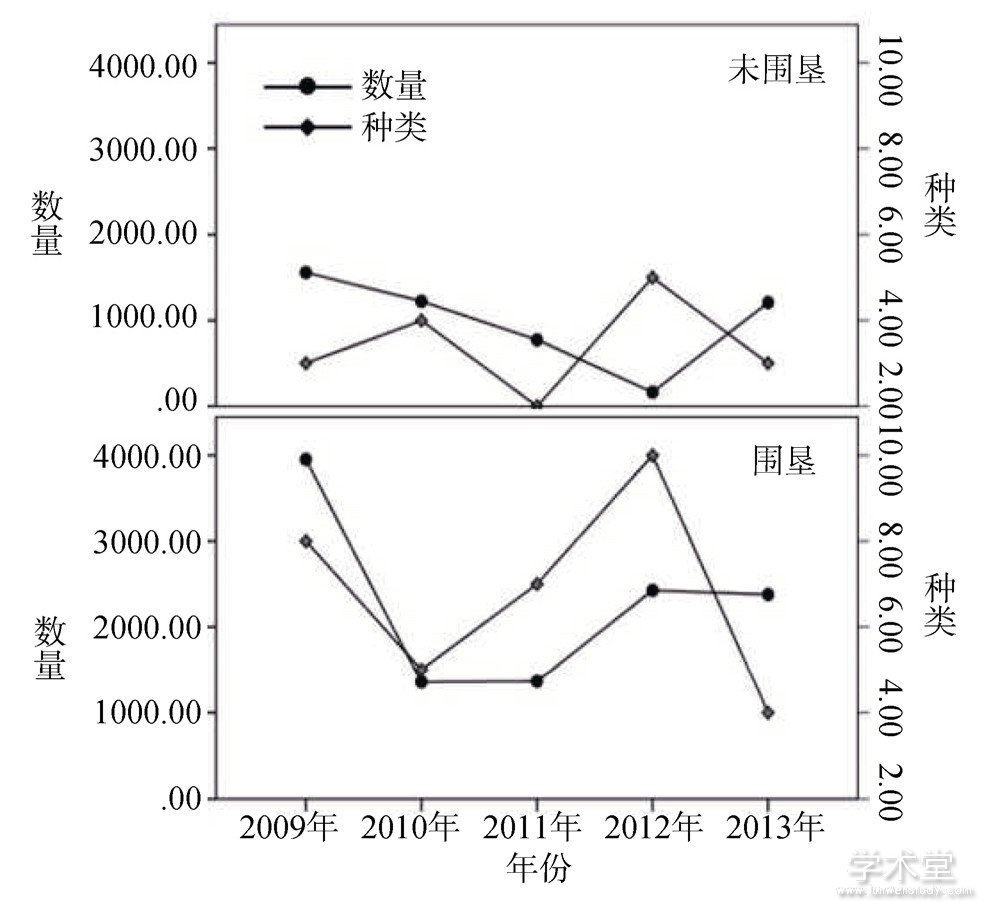
3.3 围填海对水鸟空间分布的影响
在未围垦区, 碱蓬水鸟多度最大, 其次为盐田, 鱼塘最小 (图4, 图5a) 。鹳类主要分布在碱蓬和米草中, 鹤类主要利用碱蓬和芦苇生境, 鸻鹬类水鸟在光滩、碱蓬、米草和盐田中均有分布, 鹭类在各生境中均有分布, 鸥类集中分布在光滩上, 琵鹭类分布在碱蓬和盐田, 其他水鸟集中分布在碱蓬中, 雁鸭类在碱蓬、芦苇、米草和盐田中均有分布 (图5a, 5b) ;在围垦区, 芦苇水鸟多度最大, 其次为鱼塘, 农田最小 (图4, 图5b) 。鹳类几乎没有分布, 鹤类主要利用农田, 鸻鹬类集中分布在光滩和鱼塘, 鹭类在各生境中均有分布, 鸥类集中分布在光滩且数量大幅减少, 琵鹭类分布在芦苇和鱼塘, 其他水鸟利用的生境更为广泛, 主要有芦苇、农田和鱼塘, 雁鸭类主要分布在芦苇和鱼塘 (图5a, 5b) 。
图3 围填海造成的不同土地利用类型对水鸟Shannon-Wiener指数的影响Fig.3 Effects of different land use type caused by reclama-tion on Shannon-Wiener index of waterbirds
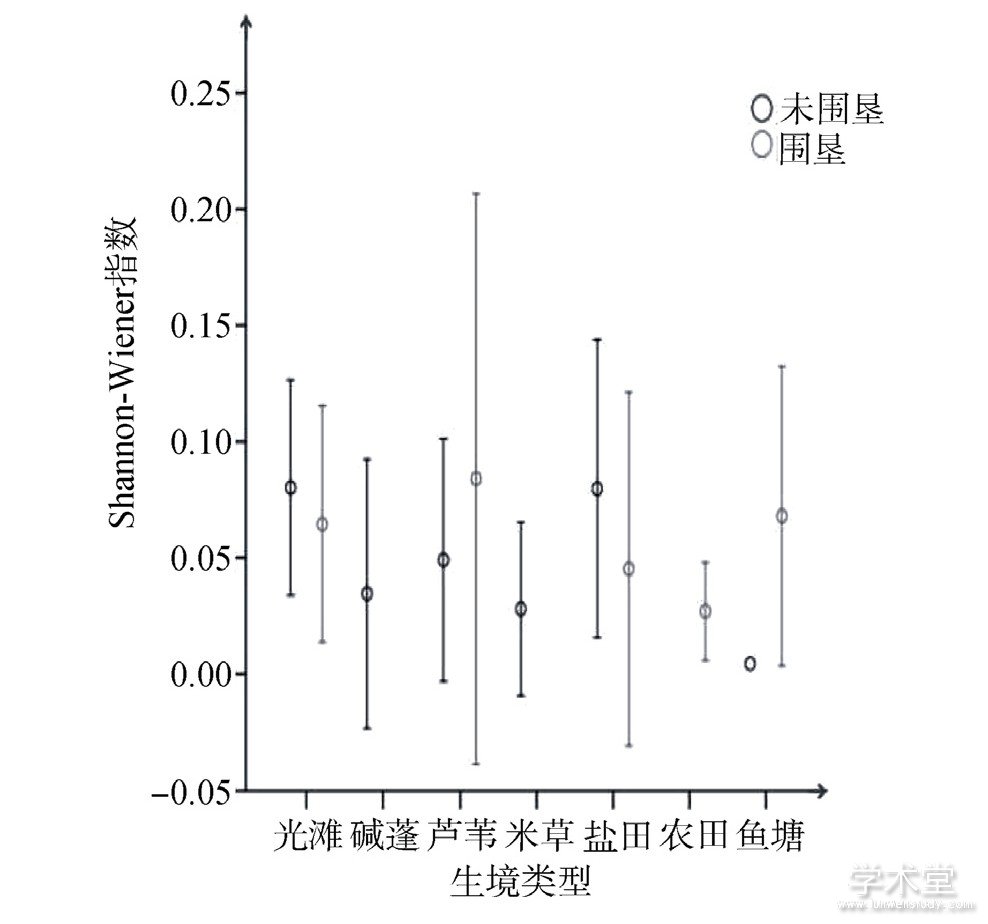
图4 围填海对水鸟空间分布的影响Fig.4 Effect of reclamation on the distribution of waterbirds
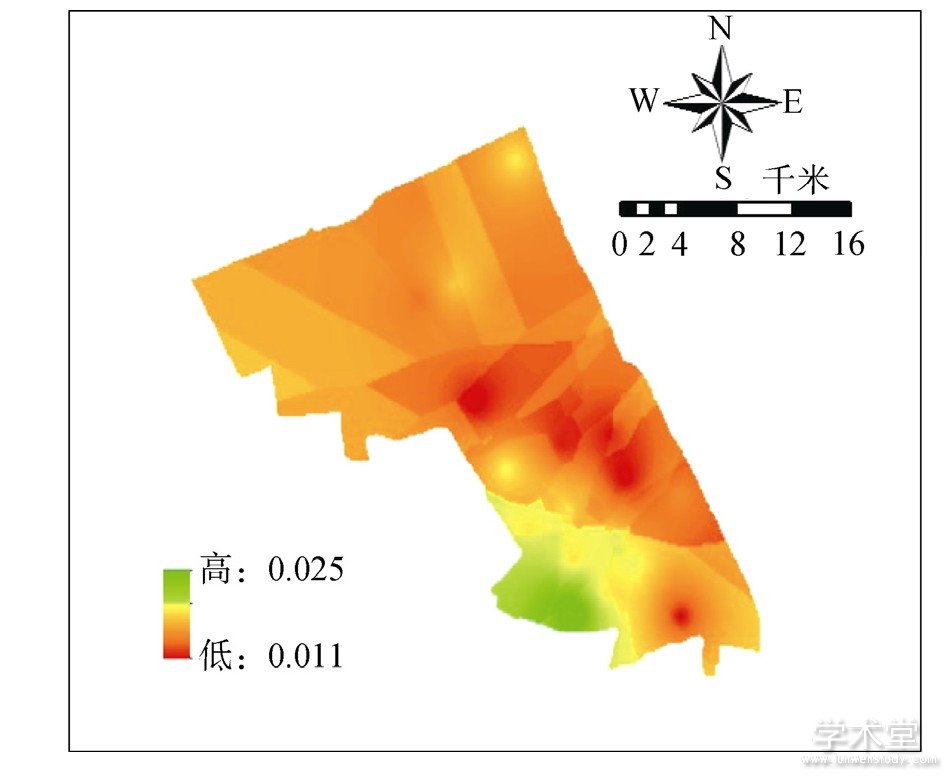
4 讨论
4.1 围填海对水鸟群落结构的影响
围填海将改变水鸟的种类组成, 而对水鸟的数量和种类数无显着影响, 其中对雁鸭类种类数和数量的增加影响尤为显着, 这与刘吉平等[18]发现适当的围垦使得水鸟生境多样化, 有利于生境泛性水鸟数量的增加的结果一致。雁鸭类作为生境泛性鸟类[19], 往往偏好于养殖塘和芦苇生境, 这也是围垦地区雁鸭类水鸟种类、数量增加的主要原因。有研究表明围垦后的养殖塘内水位较深、水源清洁、植被茂密, 不仅能为雁鸭类、鹭类等水鸟提供丰富的食物, 更能提供隐蔽的环境, 减少被天敌发现的几率[19]。虽然适当的围垦有利于生境的多样化, 但是这种改变往往不适宜生境专性鸟类的生存。鸻鹬类作为生境专性鸟类[20], 围垦后常不适应于新生境而导致种类和数量减少[21], 这与本研究中围垦对鸻鹬类水鸟种类数量无显着影响结果不一致, 因为在本研究中围垦后存在大面积的光滩供鸻鹬类栖息觅食。此外, 对于依赖于自然湿地的鹤类和鹳类, 自然生境面积下降是导致其数量骤减的主要原因[22]。鹤类、鹳类体型较大, 对食物和栖息地空间范围的需求更大, 围填海后其栖息地空间往往变小从而导致其数量下降[23]。有研究表明在崇明东滩, 白头鹤 (G.monacha) 由于围填海的影响不能获得充足的食物和栖息环境而出现数量下降甚至种群消失的趋势[24]。
围填海使得鱼塘和芦苇水鸟的多样性增加, 推测可能的原因是围垦后鱼塘和芦苇生境交错, 使得该区域内生境多样化, 这与刘吉平等[18]发现局部小生境的异质化有利于提高鸟类群落多样性的结果一致。而对于围垦后的盐田、农田、光滩生境, 由于晒盐、养卤虫、种植、挖蛤等人类活动, 导致生境内水鸟多样性降低。有研究表明围垦后开发成的经济效益带常因人为干扰大而不适合水鸟生存[8]。此外, 研究区内盐田、农田等生境往往存在着抗生素、有机污染物、氮磷营养盐和重金属等外界污染源[25,26,27], 水鸟摄取这些区域内的食物后, 有害物质富集, 生理机能下降导致死亡[28]。
图5 不同土地利用类型对水鸟群落组成的影响Fig.5 Effects of different land use types on the community composition of waterbirds
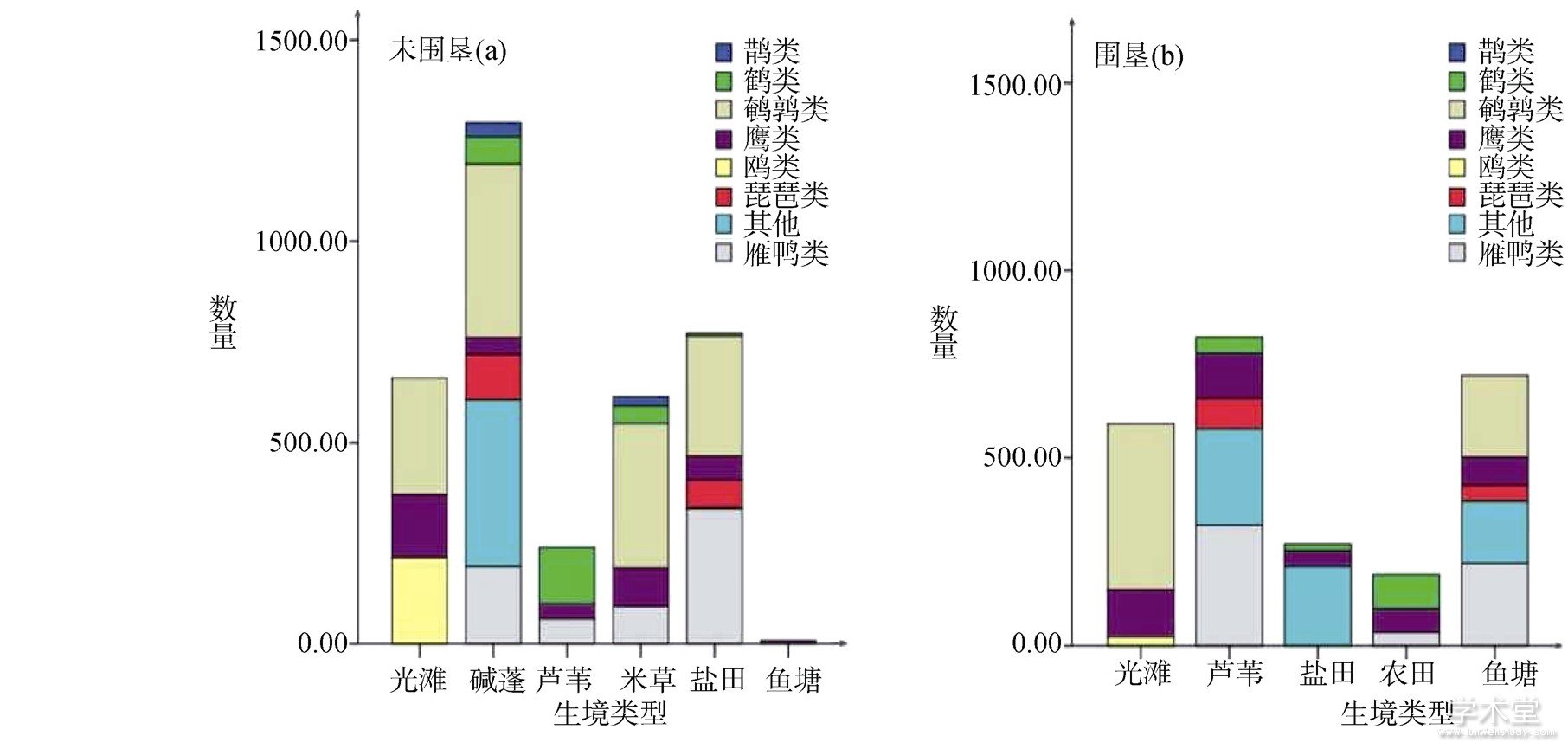
4.2 围填海对水鸟空间分布的影响
围填海对水鸟空间分布的影响与围生境的可利用性[29,30]和人为干扰大小[31]有关。在未围垦区, 鹳类主要分布在碱蓬和米草等自然生境中, 而在围垦区, 鹳类几乎没有分布, 这与Park等[32]发现鹳类倾向于选择植被较高、隐蔽条件较好、人为干扰少的环境的结果相一致, 可见围填海的进行对于鹳类的生存极为不利。未围垦区内鹤类主要利用碱蓬、芦苇、米草生境, 而在围垦区没有碱蓬和米草生境, 鹤类将农田作为补充生境, 已有研究表明鹤类中的某些种类已适应于人工湿地[33], 但是农田的人为干扰远大于碱蓬、米草等自然生境, 这将对鹤类的生存造成严重威胁[34]。由于核心区的开发利用强度远远小于北缓冲区[35], 导致相同生境条件下, 位于核心区的生境的水鸟多度高于北缓冲区, 这与Rogers[36]发现人为干扰越少的生境, 水鸟选择栖息觅食的几率越大相一致。核心区的滩涂未开发利用, 人为干扰较小, 所以大多鸻鹬类水鸟在此栖息觅食[37]。有研究表明鸻鹬类水鸟中鸻属 (Charadrius) 、滨鹬属 (Charadriiformes) 和杓鹬属 (Numenius) 通常在滩涂上取食, 只有在高潮期才会飞落在鱼塘和盐田中可利用的滩涂上栖息[38,39,40], 而反嘴鹬 (Recurvirostra avosetta) 、黑翅长脚鹬 (Himantopus himantopus) 、鹤鹬 (Tringa erythropus) 、泽鹬 (T.stagnatilis) 等偏好于浅水环境[41], 围垦区的光滩和鱼塘恰好提供了这样的环境, 所以鸻鹬类水鸟在光滩和鱼塘中有较多分布。但是未围垦区鸻鹬类水鸟可利用的生境更加多样, 在围垦区仅能利用光滩、鱼塘生境, 可见围填海的进行使得鸻鹬类水鸟的生态位变窄。雁鸭类偏好于鱼塘[24], 在北缓冲区的鱼塘由于人为干扰过大, 使得水鸟几乎无分布[42], 而核心区鱼塘附近的芦苇、碱蓬提供了隐蔽环境, 加上人为干扰少, 所以雁鸭类水鸟集中分布在围垦区的鱼塘和芦苇生境。
5 结论
围填海对水鸟的种类组成影响较大, 围垦区雁鸭类水鸟的种类数量明显高于未围垦区。围填海造成的土地利用类型的改变降低了光滩和盐田的水鸟多样性, 增加了芦苇和鱼塘的水鸟多样性。围垦后的生境不适合鹳类的生存;鹤类水鸟生境多样性降低, 由原先的碱蓬、米草等自然湿地转变为农田等人工湿地[43];围垦后未被开发利用的滩涂往往是鸻鹬类集中分布的区域, 只有在高潮期鸻鹬类才会选择鱼塘、盐田生境的裸露滩涂栖息;围垦开发的鱼塘、芦苇中, 雁鸭类分布较多, 但不适合鸻鹬类水鸟觅食栖息。
附表

附表

参考文献:
[1] HALPERN B S, WALBRIGE S, SELKOE K A, et al.Aglobal map of human impact on marine ecosystems[J].Science, 2008 (319) :948-952.
[2] MENG Weiqing, HU Beibei, HE Mengxuan, et al.Temporal-spatial variations and driving factors analysis of coastal reclamation in China[J].Endocrinology, 2017 (191) :39-49.
[3]TIAN Bo, WU Wenting, YANG Zhaoqing, et al.Drivers, Trends, and Potential Impacts of Long-Term Coastal Reclamation in China from 1985 to 2010[J].Estuarine, Coastal and Shelf Science, 2016 (170) :83-90.
[4] CHEN Wengang, WANG Dongchuan, HUANG Yong, et al.Monitoring and analysis of coastal reclamation from1995-2015 in Tianjin Binhai New Area, China[J].Scientific Reports, 2017, 7 (1) :3850.
[5] MA Zhijun, MELVILLE D S, LIU Jianguo, et al.Rethinking China's new great wall[J].Science, 2014, 346 (6212) :912-914.
[6] YAN Jiaguo, CUI Baoshan, ZHENG Jingjing, et al.Quantification of intensive hybrid coastal reclamation for revealing its impacts on macrozoobenthos[J].Environmental Research Letters, 2015, 10 (10) :14004-14015.
[7] LEE J K, CHUNG O S, PARK J Y, et al.Effects of the Saemangeum Reclamation Project on migratory shorebird staging in the Saemangeum and Geum Estuaries, South Korea[J].Bird Conservation International, 2017:1-13.
[8] YANG Hongyan, CHEN Bin, BARTER M, et al.Impacts of tidal land reclamation in Bohai Bay, China:ongoing losses of critical Yellow Sea waterbird staging and wintering sites[J].Bird Conservation International, 2011 (21) :241-259.
[9] PIERSMA T, LOK T, CHEN Ying, et al.Simultaneous declines in summer survival of three shorebird species signals a fiyway at risk[J].Journal of Applied Ecology, 2016, 53 (2) :479-490.
[10] LOUISE M W, SUSAN H.Shorebird Use of South Carolina Managed and Natural Coastal Wetlands[J].Journal of Wildlife Management, 1996, 60 (1) :73-82.
[11] FAN Xuezhong, ZHANG Liquan, YUAN Lin, et al.An analysis on spatio-temporal dynamics of suitable habitats for waterbirds based on spatial zonation at Chongming Dongtan, Shanghai[J].Acta Ecologica Sinica.2010, 31 (13) :3820-3829.
[12] NASER H A.Effects of reclamation on macrobenthic assemblages in the coastline of the Arabian Gulf:Amicrocosm experimental approach[J].Marine Pollution Bulletin, 2011 (62) :520-524.
[13]LU Lin, GOH B P L, CHOU L M Effects of coastal reclamation on river ine macrobenthic infauna (Sungei Punggol) in Singapore[J].Journal of Aquatic Ecosystem Stress and Recovery, 2002 (9) :127-135.
[14] YATES M G, GOSS-CUSTARD J D, RISPIN W E.Towards Predicting the Effect of Loss of Intertidal Feeding Areas on Overwintering Shorebirds (Charadrii) and Shelduck (Tadorna tadorna) :Refinements and Tests of a Model Developed for the Wash, East England[J].Journal of Applied Ecology, 1996, 33 (5) :944-954.
[15] MOORES N, ROGERS D I, ROGERS K G, et al.Reclamation of tidal flats and shorebird declines in Saemangeum and elsewhere in the Republic of Korea[J].Emu, 2016, 116 (2) :136-146.
[16] XIA Shaoxia, YU Xiubo, MILLINGTON S, et al.Identifying priority sites and gaps for the conservation of migratory waterbirds in China's coastal wetlands[J].Biological Conservation, 2017 (210) :72-82.
[17]阮德孟, 孙勇, 程嘉伟, 等.盐城自然保护区新洋港河口不同生境冬季鸟类群落组成及其梯度变化[J].生态学报, 2015, 35 (16) :5437-5448.
[18]刘吉平, 张顺, 陈智文.人类活动对三江平原东北部湿地鸟类的干扰[J].东北林业大学学报, 2008, 36 (12) :40-42.
[19] ZOU Yeai, TANG Chendong, NIU Junying, et al.Migratory Waterbirds Response to Coastal Habitat Changes:Conservation Implications from Long-term Detection in the Chongming Dongtan Wetlands, China[J].Estuaries and Coasts, 2016, 39 (1) :273-286.
[20] HOWE M A, GEISSLER P H, HARRINGTON B A.Population trends of North American shorebirds based on the international shorebird survey[J].Biological Conservation, 1989, 49 (3) :185-199.
[21]蒋科毅, 吴明, 邵学新, 等.杭州湾及钱塘江河口南岸滨海湿地鸟类群落多样性及其对滩涂围垦的响应[J].生物多样性, 2013, 21 (2) :214-223.
[22] ZHU Hongguang, QIN Pei, WANG Hui.Functional group classification and target species selection for Yancheng Nature Reserve, China[J].Biological Conservation, 2004 (13) :1335-1353.
[23] IWAMURA T, POSSINGHAM H P, CHASES I, et al.Migratory connectivity magnifies the consequences of habitat loss from sea-level rise for shorebird populations[J].Proceedings of the Royal Society B Biological Sciences, 2013, 280 (1761) :20130325.
[24]MA Zhijun, LI Bo, ZHAO Bin, et al.Are artificial wetlands good alternatives to natural wetlands for waterbirds?A case study on Chongming Island, China[J].Biodiversity and Conservation, 2004 (13) :333-350.
[25] HU Yuanan, LIU Xueping, BAI Jinmei, et al.Assessing heavy metal pollution in the surface soils of a region that had undergone three decades of intense industrialization and urbanization[J].Environmental Science&Pollution Research International, 2013 (20) :6150-6159.
[26] LIN Haiying, SUN Tao, XUE Sufeng, et al.Heavy metal spatial variation, bioaccumulation, and risk assessment of Zostera japonica habitat in the Yellow River Estuary, China[J].Science of the Total Environment, 2015 (541) :435-443.
[27] MA Xiaoling, ZUO Hang, TIAN Mengjin, et al.Assessment of heavy metals contamination in sediments from three adjacent regions of the Yellow River using metal chemical fractions and multivariate analysis techniques[J].Chemosphere, 2015 (144) :264-272.
[28] LUO Jinming, YE Yajie, GAO Zhongyan, et al.Lead in the Red-Crowned Cranes (Grus japonensis) in Zhalong Wetland, Northeastern China:A Report[J].Bulletin of Environmental Contamination and Toxicology, 2016, 97 (2) :177-183.
[29] BURTON K H N, REHFISCH M M, CLARK A N, et al.Impacts of sudden winter habitat loss on the body condition and survival of redshank Tringa tetanus[J].Journal of Applied Ecology, 2006 (43) :464-473.
[30]GAN Xiaojing, CAI Yinting, Choi C, et al.Potential impacts of invasive Spartina alterniflora on spring bird communities at Chongming Dongtan, a Chinese wetland of international importance[J].Estuarine, Coastal and Shelf Science, 2009 (83) :211-218.
[31]CONVERTINO M, DONOGHUE J F, CHU-AGOR M L, et al.Anthropogenic renourishment feedback on shorebirds:a multispecies Bayesian perspective[J].Ecological Engineering, 2011 (37) :1184-1194.
[32] PARK S R, YOON J M, HA D S, et al.A proposal for the habitat restoration of Hwanghae regions in North Korea through the reintroduction of Oriental Storks in the Korean Peninsula[J].Reintroduction, 2017 (5) :53-61.
[33] HARRIS J.Cranes, population and nature:Preserving the balance[M]//Higuchi H, Minton J.The Future of Cranes and Wetlands.Tokyo:Wild Bird Society of Japan, 1994:1-14.
[34] CAO Mingchang, LIU Gaohuan.Habitat suitability change of red-crowned crane in Yellow River Delta Nature Reserve[J].Journal of Forestry Research, 2008, 19 (2) :141-147.
[35] FANG Shubo, JIA Xiaobo, QIAN Qingteng, et al.Reclamation history and development intensity determine soil and vegetation characteristics on developed coasts[J].Science of the Total Environment, 2017 (586) :1263.
[36] ROGERS D I.High-tide roost choice by coastal waders[J].Wader Study Group Bulletin, 2003 (100) :73-79.
[37] RAMLI R, NORAZLIMI N A.The Effects of Disturbance on the Abundance and Foraging Behaviour of Shorebirds and Waterbirds in the Tropical Mudflat Areas[J].Sains Malaysiana, 2017, 46 (3) :365-372.
[38] REHFISCH M M, INSLEY H, SWANN B.Fidelity of overwintering shorebirds to roosts on the Moray Basin, Scotland:implications for predicting impacts of habitat loss[J].Ardea, 2003 (91) :53-70.
[39] GE Zhenming, WANG Tianhou, ZHOU Xiao, et al.Changes in the spatial distribution of migratory shorebirds along the Shanghai shoreline, China, between 1984 and2004[J].Emu, 2007 (107) :19-27.
[40]侯森林, 余小韵, 鲁长虎.射阳河口春季鸻鹬类与大型底栖动物关系[J].生态学杂志, 2013, 32 (10) :2735-2743.
[41]王岐山, 马鸣, 高育仁.中国动物志[M].北京:科学出版社, 2006.
[42] BARTER M.Shorebirds of the Yellow Sea:Importance, Threats and Conservation Status[M]//Wetlands International Global Series 9:International Wader Studies 12.Canberra, Australia, 2012.
[43] LI Ning, WANG Zheng, XIA Lu, XU Lingqing, YAN Feng, QIAO Yajun, LI Xinhai, AN Shuqing, FANG Shubo.Effects of long-term coastal reclamation on suitable habitat and wintering population size of the endangered Redcrowded Crane, Grus japonensis[J].Hydrobiologia, 2017, doi:10.1007/s10750-017-3341-x.
当今世界大白猪和长白猪是最重要的商业品系肉用猪,尤其以生长速度快、繁殖力高、适应性强和瘦肉率高的特点而被人们所熟知,它是世界上最着名,分布最广的主导瘦肉型猪,全世界范围内均有饲养[1-3].据调查,国内外很多特有小型猪,如广西巴马小型猪、西藏小...
摘要:本文概述了生物多样性的概念、含义、意义和现状。指出了生物多样性减少的主要原因,涉及自然、人为及制度原因,其中人为原因主要包括:生境丧失、生物资源过度开发、环境污染、外来物种入侵。并结合我国实际情况,提出相关保护对策,如在制度方面:建...
大耳白黑眼兔特征为全身纯白色的毛被、黑眼,又称为白毛黑眼兔(whitehairblackeyesrabbit,简称WHBE兔),该兔是本研究组在实验用日本大耳白兔(JW兔)生产群中发现了一只雄性WHBE兔后,通过回交近交方式(包括同胞和半同胞之间的交配)进行保存的...
随着城市不断发展,生境逐渐丧失和破碎化,人造景观逐渐取代自然景观,人工活动对生境干扰频繁,城市中适合鸟类生存的绿地等生境面积缩小,生境质量显着降低,使得鸟类分布区域明显缩小,种类和数量也随之减少。...
野生动物作为珍贵的自然资源, 随着时代的变迁, 人为捕猎行为频发, 许多野生动物数量急剧减少, 严重威胁到野生动物生存质量。本文将对野生动物保护在生物多样性保护中的作用进行分析。...
鸟类作为生态系统的重要成员,在维持生态系统稳定、制约捕食者-猎物的密度、传播植物种子等方面发挥着重要作用(郑光美,2012).鸟类群落的研究是群落生态学的重要研究内容,鸟类群落结构在一定程度上是鸟类与环境及鸟类种间相互关系的综合反映,可视为环境...
本文综述了啮齿动物遗传多样性在鼠害防控、啮齿动物起源和分化及进化历史、啮齿动物的适应潜力、种群数量动态和调节机制、保护生物学方面研究中的应用...